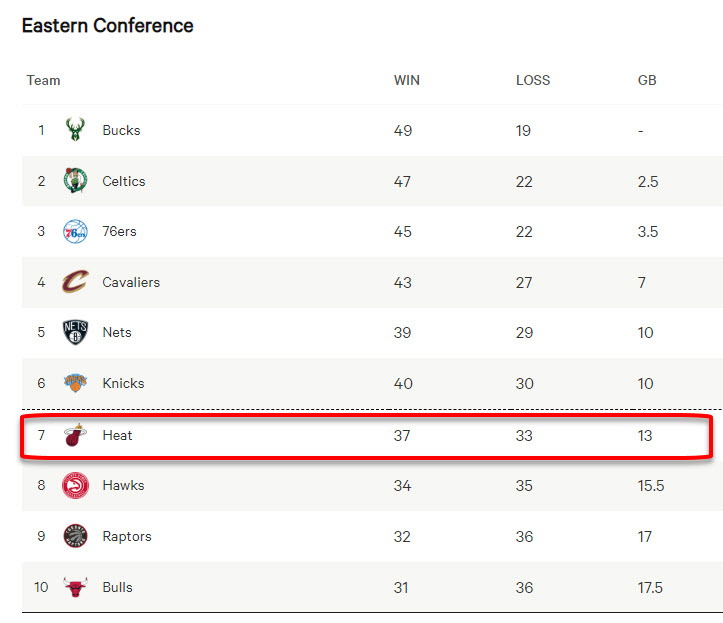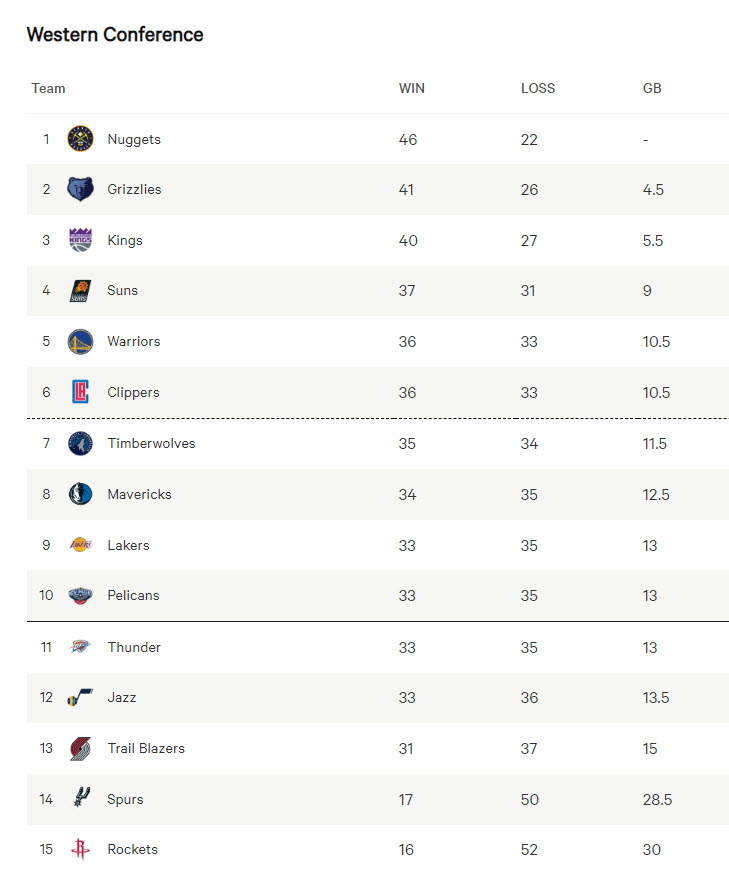In an earlier piece, I mentioned how, when watching a game, the commentators can announce an abbreviation or a phrase that’s completely unheard of to you.
At that point, you may wonder where that particular term came from as well as start to wonder what it means.
Hey, as someone who was once upon a time a basketball newbie, I completely understand that the sport is full with terminologies that most basketball fans may not be familiar with.
That’s why this blog was created, as it serves to lend a helping hand to the beginners of the game.
In today’s article, we’ll be covering what the GB term in basketball stands for.
As always, we’ll start with a quick summary of its meaning…
In basketball, GB is an abbreviation which stands for “games back” or games behind”. It’s an expression used to indicate the difference between the leading team and another team in a particular conference, division or league.
Read on to find out more about this interesting metric.
How does the games behind concept actually work?
What better way to show you how the GB statistic works than by using an actual example from the NBA.
Have a look at this particular snapshot of the Eastern Conference standings:

It shows the Milwaukee Bucks leading the rest of the pile, with the Boston Celtics coming in close behind.
As you can see, the first two columns (i.e. “WIN” and “LOSS”) beside each team name represent the number of wins and losses each team has accumulated over the course of the campaign.
Once the season concludes, each team will have a win loss combination that, when added up, amounts to 82, which is the total number of games that are played in the regular season.
The third column – which is GB – is then used to figure out how many games back certain teams are from the very top of the conference.

For example, in the case of the Cleveland Cavaliers using the standings above, they are 7 games behind the first placed team.
So each team’s GB figure basically refers to the number of winning games that they sit behind the conference, division or league leader.
What this also means is that the higher a team’s GB value, the further away they are from the first-place position in the standings, and in most cases, the poorer that team’s performance has been over the season.
On the other hand, the division champion has the most wins and fewest defeats of any team in the conference/division.
This leader always has a GB of zero, which is represented by a dash sign (–), indicating that the team is zero games behind.
A team with few wins and many losses, for example, may have a GB figure of 6, indicating that it is six games behind the leader in the conference, division or league.
Consequently, the NBA includes the GB column to give a better representation of the gap in results between the teams being compared.
How do you calculate games back in basketball?
The easiest way to calculate a team’s GB is to separate their wins from their losses.
Let’s take the example of this seasons Miami Heat in the Eastern Conference.

They’ve won a total of 37 matches at the time of writing, while losing 33.
Now compare those figures for the top team in the conference – the Milwaukee Bucks.
You’re looking at 49 wins and 19 losses.
From there, we move on to the first step, which concerns:
1. Getting the win differential
If you subtract the total wins of the Bucks (i.e. 49), from the total wins of the Heat (i.e. 37), you get a figure of 12.
Then keep that number in your mind and proceed to get the games behind for wins, which is achieved by dividing the winning differential by an integer of 2.
This means 12 divided by 2, which equals 6.
Next step…
2. Get the loss differential
Now subtract both team’s loss totals from each other, with the lower ranked team’s loss total coming first.
We have the Bucks with 19 losses and the Heat with 33 losses.
That means you’ll subtract 19 from 33 to give you a figure of 14.
So, you now have to get the games behind for losses figure, which is that loss differential of 14 divided by 2.
We end up with 7.
Final step…
3. Add games behind for wins and games behind for losses
Summing up 6 and 7 attained from steps 1 and 2 gives us a total games back of 13.

This is what you see in the Eastern Conference standings listed above.
Why are games behind important in the NBA?
This information is critical for a couple of reasons.
Have a read below.
NBA title odds
Several sports fans, news sites, podcasters, and experts use GB data to predict which team will win the season.
Particularly as the season draws to a finish, the games back column comes in handy, as it quickly assesses whether a club has the statistical ability to catch up to a competitor in the standings.
It may also be used to measure the winning team’s dominance at the end of the season and analyse the size of the gap it created over the course of a particular campaign.
Playoff seeding
Games behind are also important to teams looking to finish in the so-called “playoff spots”.
In the NBA’s Eastern and Western Conferences, direct playoff spots are given to the top six teams ranked in order of winning percentage.
Following on from that, the teams sat in seventh to tenth get a chance to make the playoffs through a play-in tournament.
Utilizing the GB metric, sports experts and die-hard fans can try to predict which teams will make the playoffs, as well as which teams will fall short of the playoff mark.
This is because the GB number indicates how many games behind one team is from the first-placed team, which can be useful for comparing the teams in and around the playoff mark to other nearby teams in the standings.

For example, in the picture above, the Portland Trail Blazers are 15 games behind whereas the Los Angeles Lakers are 13 games behind.
This basically means that Portland are only 2 games behind the Lakers and have a fairly good chance of catching and surpassing them on their way to a higher playoff seeding spot.
It’s also important to note that the concept of “games behind” within the context of a NBA season is simply a roadmap to the postseason playoffs.
There aren’t any winning guarantees.
So, just because you’re the top seed doesn’t mean you’re guaranteed to make the final round, or even get out of the first round.
Although an upset in the first round is highly unlikely – having happened only 5 times in NBA history – those couple of instances mean there’s always a chance of a lower seed upsetting a competition favorite.
Potential first round bye
Even though a team doesn’t have to finish in first place within their division or conference in order to win the overall title, it’s an ideal position to be in as the playoffs approach.
In other North American sporting competitions like the National Football League (NFL) or Major League Baseball (MLB), teams are awarded what are called first round byes as a reward for coming in first place within their conference or division.
It essentially gives them a free pass into the second round without having to play an opponent in the first, which can be advantageous as the teams given first round byes have more time to prepare for their next opponent as well as physically recover from past fixtures.
Therefore, teams in other sports utilize the games behind metric to see how far they are from clinching a first round bye, which is received by coming top of the standings.
Conversely, finishing in first-place within the NBA standings is beneficial for a couple of reasons.
One of these is that the team in first gets to play the worst seed – which is the eighth seed in the playoff format– and be heavily favored to beat that team in the first round.
This is almsot similar to a first round bye in other sports, because the opponent in question is easily beatable.
More so, finishing in first gives that particular team guaranteed home-court advantage throughout the first three rounds of the playoffs, which can make the difference between lifting that prestigious NBA trophy or not.
Final thoughts
Essentially, games behind helps one know if a basketball team has a chance to make the playoffs or if their season is done and dusted.
The more GB you incur as a team, the more likely you are to fail to make the post season playoff rounds due to being eliminated.
On the flip side, the lower a team’s GB is, the higher their chances of winning the conference or division, of course with appropriate strategy and effort.
Now this article has certainly been quite an eye opener into the world of basketball statistics.
Should you wish to go further down the rabbit hole, have a look at one of our other posts which covers what APG is in basketball; our article on what the ISO expression means in basketball or our post on what the FG abbreviation means in basketball.
Alternatively, you can educate yourself on what the seeding system is in basketball.
Happy reading!
- The Most Popular Prop Bets Made During the NCAA Final Four Tournament - February 9, 2024
- Evaluating the Enigma: Does LeBron James Possess a No-Trade Clause? - May 16, 2023
- Gravity’s Dance: Unveiling the Art of Bouncing Basketballs - May 16, 2023

